Carrie: 11 Big Differences Between The Book And Movie

When director Kimberly Peirce announced her plans to re-imagine Carrie, fans of the 1976 Brian De Palma film called foul. How dare she remake a horror movie as iconic as this terrifying tale of a bullied teen girl turned telekinetic mass-murderer? And who could possibly hope to fill the shoes of Sissy Spacek and Piper Laurie, actresses who each earned Academy Award nominations for their harrowing portrayals of the dysfunctional yet devout mother-daughter team Carrie and Margaret White?
But Peirce and her cast--which boasts Chloe Grace Moretz and Julianne Moore in these tricky roles-- insisted their movie would be pulling its influences more from original Stephen King book than the De Palma movie it inspired. Now that Peirce's version has hit theaters, we put her promise to the test, comparing the latest Carrie movie to King's tragedy-filled novel.
I was surprised by how much of the film is pulled straight from the book, from dialogue scenes between kind-hearted queen bee Sue Snell and her beloved boyfriend Tommy Ross, to Margaret's gruesome belief that her pregnancy was actually a cancer, and the extension of Carrie's carnage beyond that blood-drenched prom. However, Peirce still took several noteworthy liberties from the original text. And we'll break them down below.
There are many spoilers for the Carrie book and film below. If you wish to remain surprised, read no further.
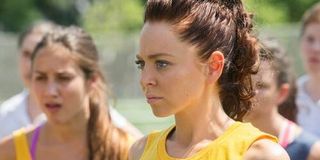
While King's book was set in 1979, this Carrie is set in a modern-day small town, perhaps to help set it apart from its 1970s movie predecessor. For the most part, this leap of thirty-four years makes for superficial differences, like pop culture references to Tim Tebow and Dancing with the Stars, or Carrie researching her abilities by using the internet to search for info on "magic powers" and telekinesis. But with the rise of cell phones and easy access to the web, Carrie's main tormenter Chris Hargensen has a new weapon at her disposal: cyber bullying.
In this movie version, Chris doesn't only taunt Carrie in the locker room showers, she posts this "Plug it up!" catastrophe on Youtube, where everyone else can easily see it and join in on the mockery of "Crazy Carrie." Upping the ante on this torment, the vid is later played on a big screen at prom to humiliate Carrie further post pig blood shower.

Gone are the flashbacks and outsider interpretations. Beginning with Carrie's grim birth, then leaping forward to the traumatic day of her first period, prom, and thereafter, Peirce's movie is told in a straightforward manner. King's novel is non-linear, switching between a present tone and looking back as it is divided into omniscient storyteller sections, newspaper clippings that report death tolls, witness testimony, and two fictional books, one written by a proponent of telekinesis, the other, a memoir penned by survivor Sue Snell. Peirce does away with all of this save for a short scene in which Sue testifies before a stern commission, "You want an explanation? Carrie had some sort of power. But she was just like me…but we pushed her. And you can only push someone so far before they break."
CINEMABLEND NEWSLETTER
Your Daily Blend of Entertainment News
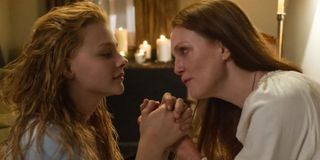
Carrie and Margaret are slimmer and prettier. In his version, King is blunt about Carrie's appearance, calling her plain, pimpled, and fat with "bovine" reactions. He later amends this slightly, through the perspective of Tommy Ross, writing, "She was far from repulsive. Her face was rather round than oval, and the eyes were so dark that they seem to cast shadows beneath them like bruises. Her hair was dark ash blonde, slightly wiry, pulled back in a bun that was not becoming to her. The lips were full, almost lush, the teeth naturally white. Her body for the most part was indeterminate." For her part, Margaret is described even less kindly: "Margaret had a face like the ass-end of a truck and a body to match." While Peirce tries to play down Moretz and Moore's good looks with slapdash braids, homely wardrobe and make-up that makes them look gaunt, both are still miles away from matching King's concept for their characters.

Carrie's dress is slinky and pink, all the better to be stained by blood. It's delicate looking with thin straps and a low-cut neckline that shows off her "dirty pillows." In the book, King describes her dress in detail, and it is more a sign of foreboding than a perfect canvas for pig's blood. Made by Carrie out of crushed red velvet, her prom dress has a princess waistline, Juliette sleeves, and a simple skirt. Still, Peirce's movie does have a nod to this dress in Sue's unworn prom gown, which is a bright blood red.
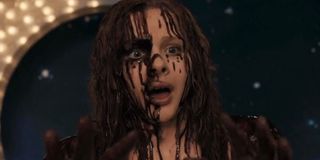
Carrie's powers begin as a teen. In the film, Carrie's telekinetic prowess is first shown in the shower scene, where her panic shatters a light bulb and causes tampons and sanitary napkins to lurch away from her. However, King offered a major incident in his story that clearly displayed Carrie's abilities surfaced when she was just a little girl. Following an argument over a neighbor in a skimpy bathing suit, Margaret tries to kill Carrie. The neighbors hear cries, and then a storm of rocks comes raining down on the White home, and only on the White home. In Peirce's version, this rock rain falls after the prom, once Carrie has killed her mother, and seeks her own death.

Carrie lacks the ability to communicate telepathically, but now she can fly. On prom night, Carrie kills many of her classmates by willing their bodies into walls, and sparking electrocutions and fires with her brain. At one point, she can even propel her own body to fly across the gym to duck out as the whole building collapses in flames around her. But Peirce opted out of Carrie's ability to telepathically share her feelings and thoughts with those around her, which was among the book's eerier elements.
In King's story, Carrie's ability to get into people's heads is shown in a few different ways. First, when Tommy asks her out, he's overcome by a weird sensation, which appears to be him feeling Carrie's excitement and anxiety. Later, a local drunk says that when he stumbled out to see his town on fire, he knew it was Carrie White who did it, and explains to his interrogators she said this to his mind. Sue also has a telepathic connection with Carrie. It's this that spurs her to leave her home and race to the school on prom night. In the movie, this thread is ditched completely and Sue comes because Chris sends her the ominous text message: "Your girl looks good but she won't for long."
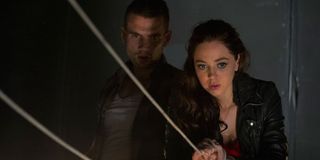
Chris doesn't come up with the pig's blood plan, but she does get her hands dirty. In both versions, Chris is slumming it with Billy, a boyfriend who is older, poorer, and skeevier than she. But in King's story, Chris masterminds Carrie's prom night humiliation, but delegates collecting the pig's blood to Billy and his no-good hangers-on. Peirce's version has Billy surprising Chris by taking her to a pig farm, and demands she pick out which pig they'll kill for its blood. Chris does so with relish, and even slits the poor beast's throat with a smile.
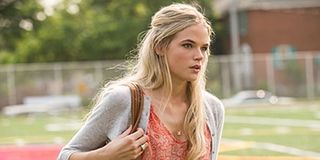
Sue Snell makes it to prom. After getting Chris's cryptic text, Sue races to the school and realizes too late what her former friend has planned. Before she can warn the crowned Carrie, well-meaning gym teacher Ms. Desjardin shoves her out of the auditorium, where all she can do is watch as the mayhem unfolds. However in King's version, Sue never makes it into the school. Carrie's telepathic cry for help signals her once the blood has been spilled, and by the time she arrives, the school and the town, including a nearby gas station, are already being swallowed by flames.
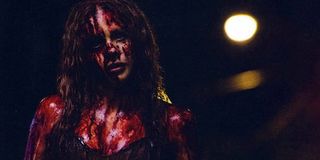
Post-prom events are shuffled. After killing most of her graduating class, Carrie stumbles bloody and barefoot out of the school, and follows Chris and Billy as they try to escape. She uses her powers to send their vehicle into gruesome collisions that kill them both. Then, she goes home to seek comfort from her mother, which of course doesn't go well. After Carrie has murdered Margaret, Sue stumbles in and Carrie asks her--with her mouth--why she had to get involved. Then, she telekinetically throws Sue free of the White home, and collapses it onto herself.
In the book, Chris and Billy flee the prom and retreat to a roadhouse for some post-prank sex. Carrie goes home, where she has the fatal confrontation with her mother, who stabs her in the heart. (She does this in the movie too.) From there, Carrie wanders to the roadhouse, where her mother told her she was conceived, and there she kills Chris and Billy by hurling them and their vehicle into the sketchy bar. Finally, Sue shows up, drawn by Carrie's mental messages of distress. Telepathically, Carrie speaks with her, forgives her then dies in her arms.
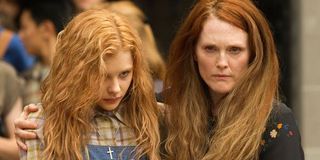
Sue's baby lives. When she is entreating Sue to leave her crumbling home, Carrie recognizes Sue is pregnant, carrying Tommy's child. "It's a girl," she tells Sue before flinging her to safety. Sue is also pregnant in the novel, but after Carrie's death, she discovers blood on herself, and knows she has miscarried.
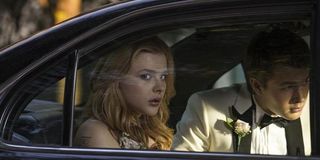
Carrie doesn't know why Tommy asked her to prom. One day Carrie White is having crass graffiti sprayed on her locker and being taunted by a locker room full of her peers. The next, the most popular boy in school is asking her to prom. In the movie, Carrie confides to the compassionate Ms. Desjardin that she doesn't know why Tommy would ask her out. In response, she gets a pep talk about how pretty she is along with some make-up tips. From here, Carrie actually allows herself to believe Tommy might like her, like that way.
In King's book, that weird feeling Tommy experiences after asking Carrie out also seems to be a side effect of Carrie reading his mind. It's clear in the novel that Carrie knows Tommy wanted to take Sue, but Sue was essentially giving him as a prom date to Carrie as a gift, and penance. Carrie accepts this offer less because she has hopes for romance, and more because she so badly wants just to feel like a normal teen girl.
This poll is no longer available.
Carrie is now in theaters.
Staff writer at CinemaBlend.
Most Popular




